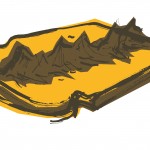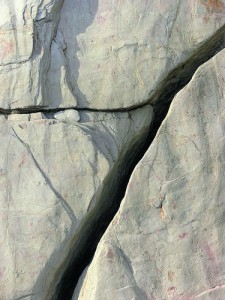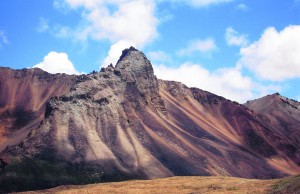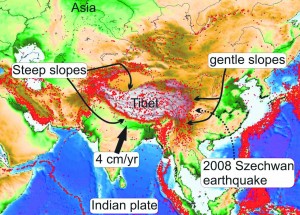SATURDAY, 7 MAY 2011
At school we are taught the theory of plate tectonics, originally developed during the 1960s. We learn how the Earth’s surface is divided into about 14 rigid plates that are slowly moving across the surface of the planet. The theory has a simple elegance: only three parameters for each plate are required to describe all of the observed motions. However, plate tectonic theory cannot explain the movement and formation of all regions of the Earth, and an exciting and vigorous area of research within the Earth Sciences is trying to understand the regions where plate tectonic theory does not work.The rocks that form the continents are extremely diverse. They have been formed in a variety of different ways and have ages of formation varying from over three billion years ago to the present day. In contrast, those underlying the oceans were all formed by volcanic activity, along the network of undersea mountain ranges where plates are moving apart. These different origins have led to significant differences between the chemical composition of the rocks forming the oceans and those underlying the continents. Consequently, there are differences in the strengths of the rocks. The strong oceanic plates break along narrow plate boundaries, such as at the mid-ocean ridges, and behave exactly as set out in the theory of plate tectonics. However, the most dramatic mountain ranges on Earth, such as the Andes, the Himalayas, and the Tibetan Plateau, have grown where some of the weaker continental regions have been squashed between converging plates. One such example is southern Asia, where for the past 50 million years India has been colliding with Asia at the geologically rapid rate of 4 centimetres per year. The Tibetan Plateau and the region extending thousands of kilometres to the north is being deformed by this plate convergence, resulting in the unfortunate occurrence of many earthquakes. Unlike the stable interiors of tectonic plates, the entirety of this area is actively deforming. It is in regions such as the Tibetan Plateau that we have been required to develop an alternative to the theory of plate tectonics in order to understand what is happening.
The presence of earthquakes, which occur when two blocks of brittle rock suddenly slip against each other, shows the Tibetan Plateau to be actively deforming. However, this only tells us about what is happening in the uppermost layer of the Earth. The thickness of this brittle layer is tiny, equivalent to less than 0.2% of the Earth’s radius and less than 10% of the upper layers of the planet that participate in mountain building and plate tectonics. Deeper within the planet the temperatures are hotter, which means that defects in the crystal lattices of minerals are able to move with increasing ease (the diffusion and dislocation creep that will be familiar to many scientists from other disciplines). This movement of lattice defects causes the rocks composed of these minerals to behave as viscous fluids, with a viscosity over 1020 times greater than honey. Mountain ranges can therefore be imagined as piles of very thick custard left out to cool. Earthquakes become the tearing of the cool skin on the surface. Given this fluid-like behaviour of the majority of the mountain ranges, we can use the rich body of fluid dynamics research to understand how the ranges behave, and shed light on the forces that cause the earthquakes.
Such research has recently been conducted on the Tibetan Plateau. The figure shows that the southwestern (Himalayan) and northern margins of the Tibetan plateau are steeply sloping, whilst the northeastern and southeastern sides have much more gentle gradients. Because of their geological histories over the past few billion years, the rocks that form peninsular India and those in the lowlands on the northern side of the Tibetan Plateau are very hard and inert. This is because in previous episodes of mountain building, the rocks have been heated to extreme temperatures. Although they have since cooled down, all of the volatile constituents, which serve to weaken the rocks as a whole, have been melted out of them. In these regions the convergence between the Indian and Asian plates forces the rigid lowlands underneath the mountains. The mountains ooze outwards under their own weight, over-riding the lowlands like a dollop of custard spreading under its own weight across a slice of toast, known as a ‘gravity current’. Fluid dynamics tells us that in this situation the flow forms a very distinctive shape with a flat top and a steeply sloping front, as we see on the northern and southwestern sides of Tibet. The gentle slopes on the northeastern and southeastern sides of Tibet show that the story here is clearly different. In these regions, there are no hard rocks being pushed under the edges of the mountains, as is the case in India, so the mountains spread out over hotter and weaker underlying material. Our custard is now spreading over the surface of a tank of olive oil, rather than a slice of toast. In this case fluid dynamics tells us that gentle slopes should form, as we see on the eastern edges of the mountain range. The notable exception is the location of the devastating magnitude 8 earthquake that occurred in the Sichuan province of China in 2008. Here we see steep slopes because the Sichuan Basin is a region of hard rock (much like India), with the mountains oozing out over it. The earthquake was a manifestation of this motion in the brittle upper layer of the Earth—the skin on the top of our custard.
Treating the Tibetan Plateau as a pile of viscous fluid has shown that we can understand the shape of the mountain range and the earthquakes within the region by applying our existing knowledge of fluid dynamics. So the next time you’re eating Marmite on toast, take a moment to place a large dollop in the middle of the slice and look at how it spreads out under its own weight; by doing this you are recreating southern Tibet and the Himalayan mountains in miniature.
This story, however, carries a sobering postscript: the same processes which are occurring in the Himalayas are also occurring in the region of the devastating Sichuan earthquake. This means it is only a matter of time until a similar or larger earthquake rocks the very densely populated Ganges River Valley—an event which, as historical records show, has happened many times in the past.
Alex Copley is a Research Fellow in Pembroke College and the Department of Earth Sciences




